GRANADA, SPAIN
We had thought about visiting Granada while sailing west along Spain’s southern coast in August, but it was very foggy, we were tired, and we just wanted to get to Gibralter. Then while in Gibralter (actually, La Linea), we were waiting for a weather window to leave, and we had the opportunity to land travel to Granada.
There is bus service from La Linea to Granada via Malaga, and there is train service from nearby La Roque. We decided to take the bus one way and the train the other. The bus trip was ok, but the train trip was a particularly nice ride.
The city Granada is the capital of the province of Granada in Andalusia, Spain. It is at the base of the Sierra Nevada Mountains (elevation approximately 2,500 feet) and at the confluence of three rivers.
The Moors founded Al-Andalus (Moorish Spain) in the 8th century after the Umayyad conquest of Hispania. However, the actual founding of Granada occurred in the 11th century during a civil war, and the Berber general Ziri ibn Manad established his kingdom there. This era was followed by the Nasrid Dynasty in the 13th century, the longest lasting Muslim dynasty on the Iberian Peninsula.
The Nasrid Dynasty surrendered Granada to the Spanish crown near the end of the 15th century, and this completed the Reconquista of the eight hundred year Moorish occupation in the Iberian Peninsula.
A condition of this surrender was that the Muslim inhabitants could continue to practice their religion. However, in less than a decade, a cardinal grew frustrated with the slow pace of conversions to Catholicism and started a program of forced conversions. This violation of the surrender treaty provoked an armed revolt, and the Crown mandated that Muslims convert or emigrate. Both Jews and Muslims emigrated in large numbers, and those remaining – the converses – were subjected to persecution.
The Jewish quarter was destroyed. Mosques were either destroyed or converted to churches. Substantial building ensued.
The population of the city of Granada is approximately 250,000, and the population of the larger urban area is approximately 500,000. This is the 13th largest urban area of Spain. The name ‘Granada’ is Spanish for pomegranate.
Granada has a wealth of Spanish-Muslim art as well as Christian churches and cathedrals. It also still has a variety of ethnic districts that reveal life among different groups of Granada’s diverse residents.
We stayed in the Albayzin district. We visited the Alhambra – a Nasrid palace built from the 10th to 13th centuries – and the nearby Generalife. We visited the Cathedral of Granada – built in the 16th century. And we experienced Gitano Flamenco in the Sacromonte district.
There are six districts in Granada – the Realejo, Cartuja, Bib-Rambla, Zaidin, Sacromonte, and Albayzin. The Albayzin is on a hill on the west side of the river Darro. It is the ancient Moorish quarter of the city.
p>We chose to stay at the Palacio de Mariana Pineda – a ‘boutique’ hotel of only eight rooms. The hotel overlooks both Plaza de San Nicolas to the south and the Alhambra across the river. A beautiful setting.We had an unfortunate incident with the reception staff at this hotel. We booked on-line through easytobook.com. Our booking included breakfast. When we arrived with our printed booking in hand, we were told that “we have a problem”. The receptionist told us that the ‘special offer’ we had did not include breakfast. We showed her that our booking clearly stated that it did. She said it was a mistake. We do not know if the mistake was by the hotel or the booking agency, but it definitely was not ours. The hotel should have honored our booking, but they did not. We cannot recommend a hotel that does not honor its booking commitments. But we set off to enjoy this beautiful city.

The Alhambra
The Alhambra is a palace and fortress complex built by the Nasrid Dynasty – the last Muslim Emirs in Spain. Although it had fallen in to disrepair, it was ‘rediscovered’ in the 19th century, and it has been in a process of restoration since. It is now a UNESCO World Heritage Site.
The Alhambra is on a plateau above the city. It was developed as a walled town in the 11th century, and it became a royal residence in the 13th century with the arrival of the first monarch of the Nasrid Dynasty.
The Alhambra did not have a master plan, but rather it developed over time. Buildings are quadrangles with rooms opening on to a central court. Quadrangles were added as the site was developed. There are column arcades, fountains with running water, and reflecting pools. Decoration was mostly painted tiles (blue, red, and yellow) and Arabic inscriptions.
The Alhambra was substantially modified after the Christian conquest in 1492. In the early 16th century, Holy Roman Emperor Charles V demolished part of the complex to build a palace which still bears his name. Some towers were destroyed. Existing architecture was replaced with the Renaissance style of the era. Partitions were built where there had previously been none. Painting and gilding was painted over.
Today the Alhambra reflects both its Muslim and Christian past. It has been memorialized in literature, music, and film. One could easily spend a few days exploring this site.
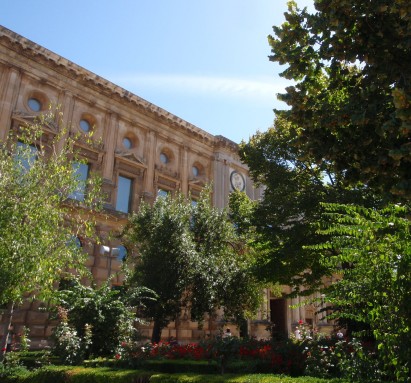
Palace and Garden at Alhambra
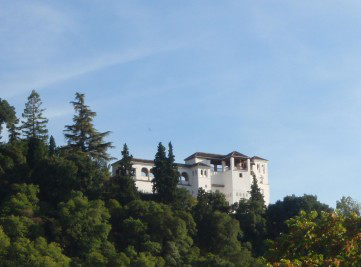
The Generalife was developed as an outbuilding of the Alhambra. This was a summer palace and country estate for the Emirs built in the early 14th century. It was designed as a place of rest and recreation for the Emirs. It is built on the slopes of a ravine, and it is visible from much of the city.
The building surrounds a long pool with flowers, fountains, colonnades, and pavilions. The Generalife is one of the oldest surviving Moorish gardens. It, too, is a UNESCO World Heritage Site.
The Generalife was once linked to the Alhambra by a covered walkway across the ravine that divides them, but that walkway is gone. The view of the Alhambra from the Generalife is beautiful.
The Granada Cathedral, also known as the Cathedral of the Incarnation, is in the center of the city of Granada. It is built over the Nasrid Great Mosque of Granada. Foundations for the church were laid in 1518, and it took another 181 years for construction to be completed.
This cathedral is massive and ornate. Its exterior has undergone significant changes over time. It original cathedral design was based on the Cathedral of Toledo, but it was transformed from a mosque to a Gothic design to a Renaissance design to a Baroque design. Its interior is even more striking with columns, paintings, sculpture, and glass work. This is the largest pipe organ we have seen. Everything is done on a grand scale.
The main chapel contains two kneeling effigies of King Ferdinand and Queen Isabella, and this chapel is their burial site. The monarchs chose the chapel as their burial site, but they both died before it was completed, and they were buried elsewhere. When the chapel was completed in 1521, their grandson, Carlos V, moved most of the dead family there. However, Philip II later moved much of the dead family to El Escorial near Madrid. The bodies of Ferdinand, Isabella, and their children Philip and Juana, remain interred at the chapel.
We wanted to listen to some flamenco and see some dancing, and we knew there were many options, so we asked around for advice. We were told that there were two basic choices. One choice was for a show with well-trained professional dancers on a stage. We were told that this was the better quality of music and dancing. The second choice was the Gitano (gypsy) performances done in their cave houses in the Sacromonte district. This was described as more like going to a gypsy party. Anyone that knows us would know that we headed for the Sacromonte.
The Sacromonte district is on the hill adjacent to the Albayzin along the Darro River. It is characterized by its many cave houses which are dug in to the hillside and its Gitano population.
We walked through the area during the day, and only the fronts of the houses are visible. It is not possible to tell how large any of them are – only their frontage. We later learned that some of them go quite deep in to the hillside.
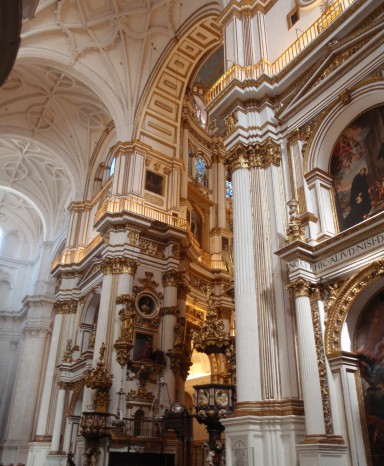
Inside the Cathedral

Outside the Cathedral
But this area comes alive after dark when many of the houses open as venues for flamenco song and dance. The Sacromonte is known for the Zambra Gitana which is an Andalusian Flamenco that originated in the Middle East – seemingly appropriate in the old Muslim quarter.
We went to a ‘show’ that included one guitar player and four female dancers. We sat in chairs lined along the walls reaching in to the cave house and sipped sangria (very popular in all parts of Spain we have visited). The guitar player sat near the entry, and the dancers performed inches in front of us – sometimes bumping in to us. It was lively, dramatic, and energetic. It was as it had been described to us – like a gypsy party. And we really enjoyed it.
We really enjoyed our short visit to Granada, but we needed to get back to Passage and refocus on trying to get out of La Linea. We had a very nice train trip back to nearby La Roque from where we had a 15 minute taxi ride back to the boat. A very nice trip.
Return to mainland Spain.
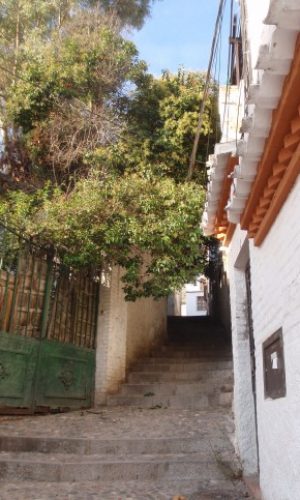
Sacromonte district by day
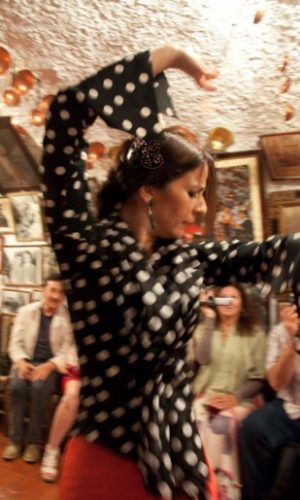
Sacromonte district by night